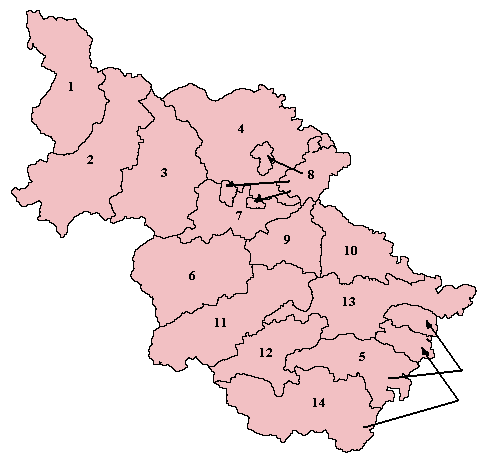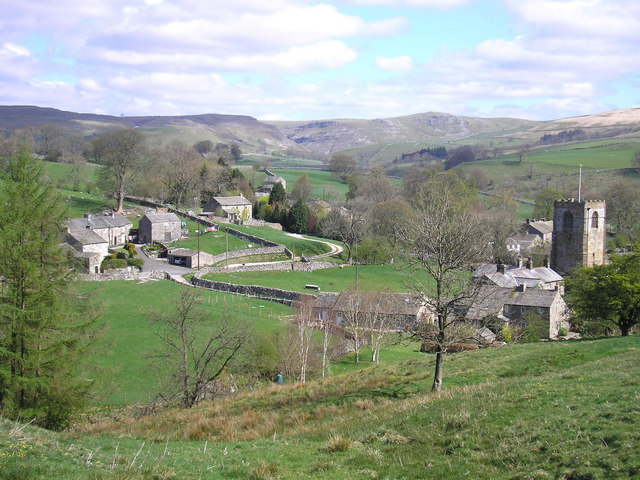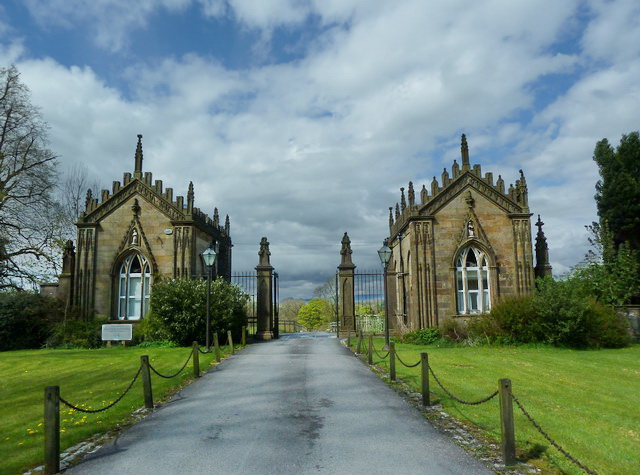|
Staincliffe Wapentake
Staincliffe, also known as Staincliff, was a wapentake of the West Riding of Yorkshire. The wapentake was named from a place called Staincliffe, now lost, in Bank Newton, not to be confused with Staincliffe near Dewsbury. Staincliffe was presumably where the wapentake originally met, although in the 12th century it met at Flasby. The wapentake was split into two divisions. The East Division included the ancient parishes of Barnoldswick, Bracewell, Broughton, Burnsall, Carleton, Gargrave, Hebden, Keighley, Kettlewell, Kildwick, Linton, Marton in Craven, Skipton, Thornton in Craven and parts of Arncliffe and Addingham. The West Division included the parishes of Bolton by Bowland, Giggleswick, Gisburn, Kirkby Malhamdale, Long Preston, Slaidburn and parts of Arncliffe, Browsholme, Mitton, and Sawley. Some parts of the Forest of Bowland attached to the Chapelry of Whitewell, were part of the Lancashire parish of Whalley in neighbouring Blackburnshire Blackbur ... [...More Info...] [...Related Items...] OR: [Wikipedia] [Google] [Baidu] |
Wapentakes Of The West Riding Of Yorkshire
A hundred is an administrative division that is geographically part of a larger region. It was formerly used in England, Wales, some parts of the United States, Denmark, Southern Schleswig, Sweden, Finland, Norway, the Bishopric of Ösel–Wiek, Curonia, the Ukrainian state of the Cossack Hetmanate and in Cumberland County, New South Wales, Cumberland County in the British Colony of New South Wales. It is still used in other places, including in Australia (in South Australia and the Northern Territory). Other terms for the hundred in English and other languages include ''#wapentake, wapentake'', ''herred'' (Danish and Bokmål, Bokmål Norwegian), ''herad'' (Nynorsk, Nynorsk Norwegian), ''hérað'' (Icelandic), ''härad'' or ''hundare'' (Swedish), ''Harde'' (German), ''hiird'' (North Frisian language, North Frisian), ''satakunta'' or ''kihlakunta'' (Finnish), ''kihelkond'' (Estonian), ''kiligunda'' (Livonian), ''cantref'' (Welsh) and ''sotnia'' (Slavic). In Ireland, a similar subdi ... [...More Info...] [...Related Items...] OR: [Wikipedia] [Google] [Baidu] |
Kildwick
Kildwick, or Kildwick-in-Craven, is a village and civil parish of the district of Craven in North Yorkshire, England. It is situated between Skipton and Keighley and had a population of 191 in 2001, rising slightly to 194 at the 2011 census. Kildwick is a landmark as where the major road from Keighley to Skipton crosses the River Aire. The village's amenities include a primary school, church and public house. History Etymology The first known documentation of Kildwick's name is as ''Childeuuic'' in the ''Domesday Book''. In Latin, the digraph ch is pronounced /kʰ/ not /tʃ/ so its pronunciation was the same as it is now. The meaning of its name depends on whether it was named by the conquering Vikings or earlier in Old English. However, no evidence of the latter is known, and other place names nearby are predominantly Old Norse. *Kild. In Old Danish ''kilde'' means either a spring like in Keld to the north, or a large smooth body of water. ''Kelda'' has its roots in ... [...More Info...] [...Related Items...] OR: [Wikipedia] [Google] [Baidu] |
Browsholme Hall
Browsholme Hall is a privately owned Tudor house in the parish of Bowland Forest Low in the borough of Ribble Valley, Lancashire (although historically in the West Riding of Yorkshire), England. It is claimed to be the oldest surviving family home in Lancashire. Since 1954, it has been designated a Grade I listed building by English Heritage. History In the fourteenth century, Edmund Parker was park-keeper of Radholme Laund, west of Browsholme, one of the two great deer parks in the Forest of Bowland. In 1393, his sons Richard and John were deputy parkers of Radholme, but from 1380, they had a lease of the vaccary (mediaeval cattle farm) of Browsholme. Richard probably built the original house on the present site around that time. When in 1507, King Henry VII disafforested Bowland, Edmund Parker obtained a copyhold of Nether Browsholme and began the present house. Thomas Parker, purchased the Freehold (law), freehold of Browsholme from the Crown in 1603 and further imp ... [...More Info...] [...Related Items...] OR: [Wikipedia] [Google] [Baidu] |
Slaidburn
Slaidburn () is a village and civil parish within the Ribble Valley district of Lancashire, England. The parish covers just over 5,000 acres of the Forest of Bowland. Historically in the West Riding of Yorkshire, Slaidburn lies near the head of the River Hodder and Stocks Reservoir, both within the Forest of Bowland, an Area of Outstanding Natural Beauty. Farming is still a major employer, but the area attracts tourists; for walking in particular. The civil parish of Slaidburn shares a parish council with Easington, a rural parish to the north of Slaidburn. According to the 2001 census, the parish had a population of 288, however the United Kingdom Census 2011 grouped the parish with Easington (2001 pop. 52), giving a total of 351. The parish church of St Andrew has a superb Jacobean screen and a fine Georgian pulpit. The brass band composer William Rimmer (1862–1936) composed the now-popular march, named ''Slaidburn'' after the village, for the Slaidburn Silver Band. A n ... [...More Info...] [...Related Items...] OR: [Wikipedia] [Google] [Baidu] |
Long Preston
Long Preston is a village and civil parish in the Craven district of North Yorkshire, England, in the Yorkshire Dales. It lies along the A65 road, and is from Skipton and from Settle. The population of Long Preston in 2001 was 680, increasing to 742 at the 2011 Census. The village was historically part of the West Riding of Yorkshire until 1974. History Early times Humans have been in the Long Preston area since prehistoric times; remains have been found in caves on the hills above Settle and an axe head dated to the Stone Age was found in the area of Bookil Gill. The presence of a Roman Road through the village, led to the discovery of a small fort in what is now part of the churchyard. Middle Ages Long Preston is mentioned in the Domesday Book, where it is described as ''Prestune'', later being registered as ''Prestona in Cravana''. Prestune means "the priest's farmstead or town". Later, the prefix "Long" was added, referring to the length of the village. Long Pr ... [...More Info...] [...Related Items...] OR: [Wikipedia] [Google] [Baidu] |
Kirkby Malhamdale
Kirkby Malham is a small village and civil parish in the Craven district of North Yorkshire, England. Situated in the Yorkshire Dales it lies east of Settle. The population of the civil parish as taken in the 2011 Census (including Hanlith and Scosthrop) was 202. Nearby settlements include Hanlith, Malham, Airton and Calton. American writer Bill Bryson once resided in the village. It has a joint parish council, Kirkby Malhamdale Parish Council, with the parishes of Malham, Malham Moor and Hanlith. See also *St Michael's Church, Kirkby Malham St Michael's Church is in the village of Kirkby Malham, North Yorkshire, England. It is an active Anglican parish church in the deanery of Bowland and Ewecross, the archdeaconry of Craven, and the Diocese of Leeds. It is recorded in the Nation ... References External links Village and area web site [...More Info...] [...Related Items...] OR: [Wikipedia] [Google] [Baidu] |
Gisburn
Gisburn (formerly Gisburne) is a village and civil parish within the Ribble Valley borough of Lancashire, England. Historically within the West Riding of Yorkshire, it lies northeast of Clitheroe and west of Skipton. The civil parish had a population of 506, recorded in the 2001 census, increasing to 521 at the 2011 Census. The civil parish adjoins the Ribble Valley parishes of Horton, Paythorne, Sawley and Rimington and the Pendle parish of Bracewell and Brogden. Etymology Gisburn is first named in the Domesday Book of 1086, where it takes the form ''Ghiseburne''. The name is next attested in the twelfth century, as ''Giselburn''. The name is thus thought to originate in the reconstructed Old English word *''gysel'' ('gushing') and the common Old English word ''burna'' ('stream'). It is possible, however, that the first element was originally an Old English personal name *''Gysla''. Thus the name once meant either 'gushing stream' or 'Gysla's stream'. The former spellin ... [...More Info...] [...Related Items...] OR: [Wikipedia] [Google] [Baidu] |
Giggleswick
Giggleswick, a village and civil parish in the Craven district of North Yorkshire, England, lies on the B6480 road, less than north-west of the town of Settle and divided from it by the River Ribble. It is the site of Giggleswick School. The village belonged to the West Riding of Yorkshire until 1974. Etymology ''A Dictionary of British Place Names'' contains the entry: :Giggleswick N. Yorks. Ghigeleswic 1086 (DB). "Dwelling or (dairy) farm of a man called Gikel or Gichel". OE or ME pers. name (probably a short form of the biblical name Judichael) + wīc. Railway station The village is served by Giggleswick railway station, which provides services to Leeds and to Lancaster and Morecambe. There are five trains a day in each direction, operated by Northern. Close to the station and opposite the ''Craven Arms Hotel'' (formerly the ''Old Station Inn'') is the Plague Stone. This has a shallow trough, which in times of plague was filled with vinegar to sterilize the coins ... [...More Info...] [...Related Items...] OR: [Wikipedia] [Google] [Baidu] |
Bolton By Bowland
Bolton-by-Bowland is a village and civil parish in the Ribble Valley district of Lancashire, England. Before 1974, the village was part of Bowland Rural District in the West Riding of Yorkshire. According to the census of 2001, the parish had a population of just 498, rising marginally to 499 at the census of 2011. History In medieval times, it was known as Bolton-''in''-Bowland, reflecting the shifting boundaries of the ancient Forest of Bowland on whose south east flank the village sits. The manor of Bolton-by-Bowland, however, was not included within the Lordship of Bowland, being a part of the Percy family fee from earliest times. It is thought that there has been a church on the site of St Peter and St Paul's Church since around 1190. The village is on Skirden Beck, near its confluence with the River Ribble. The village has a car park, toilet facilities and a tourist information centre, is the starting point for many of the area's walks. Governance Bolton-by-Bowl ... [...More Info...] [...Related Items...] OR: [Wikipedia] [Google] [Baidu] |
Addingham
Addingham (formerly Haddincham , Odingehem 1086)Mills, A.D. (2003). ', Encyclopedia.com is a village and civil parish in the City of Bradford in West Yorkshire, England. It is situated near the A65, south-east of Skipton, west of Ilkley, north-west of Bradford and around north-west of Leeds. Historically part of the West Riding of Yorkshire, it is located in the valley of the River Wharfe and is only from the Yorkshire Dales National Park. The name is thought to mean "homestead associated with a man called Adda", although in the ''Domesday Book'', the village was referred to as "Ediham", which may have referred to Earl Edwin of Bolton Abbey. The 2001 census numbered Addingham's population at 3,599, increasing to 3,730 at the 2011 Census. The area around Addingham is thought to have been populated from at least Bronze Age times, indicated by the ' cup and ring' carved stones that can be found on Addingham Moor. Its beginnings may date back to the late Mesolithic period, a ... [...More Info...] [...Related Items...] OR: [Wikipedia] [Google] [Baidu] |
Arncliffe, North Yorkshire
Arncliffe is a small village and civil parish in Littondale, one of the Yorkshire Dales in England. Littondale is a small valley beside Upper Wharfedale, beyond Kilnsey and its famous crag. It is part of the Craven district of the non-metropolitan county of North Yorkshire, but is in the historic West Riding of Yorkshire. The population of the civil parish was estimated at 80 in 2015. Overview Situated on a gravel delta above the flood-plain of the River Skirfare, Arncliffe's houses, cottages, and other buildings face a large green, and green hillsides etched with limestone scars. A barn to the north of the green is a good example of the local style, with an unusual entrance, and a datestone of 1677. Behind the village buildings are several small crofts, nearly one to each house, and beyond these, limestone walls climb the surrounding hills separating higher fields. St Oswald's church lies close to the river a little north of the village, and the road up the dale crosses t ... [...More Info...] [...Related Items...] OR: [Wikipedia] [Google] [Baidu] |
Thornton In Craven
Thornton-in-Craven is a village and civil parish in the Craven district of North Yorkshire, England. It is approx from the border with Lancashire and north of Earby. Barnoldswick is nearby. The Pennine Way passes through the village, as does the A56 road. The village has a church, a primary school and a retirement home, but no shops or pub. Near the medieval church to the west of the village is a holy well, dating from Saxon times and now covered by an octagonal structure erected in 1764 by the rector. Thornton-in-Craven railway station was closed when passenger trains over the Skipton to Colne route were withdrawn in 1970. SELRAP are actively pursuing a re-opening of the line which was given a boost in February 2018, when the transport minister, Chris Grayling Christopher Stephen Grayling (born 1 April 1962) is a British Conservative Party (UK), Conservative Party politician and author who served as Secretary of State for Transport from 2016 to 2019. He has served ... [...More Info...] [...Related Items...] OR: [Wikipedia] [Google] [Baidu] |

.jpg)






